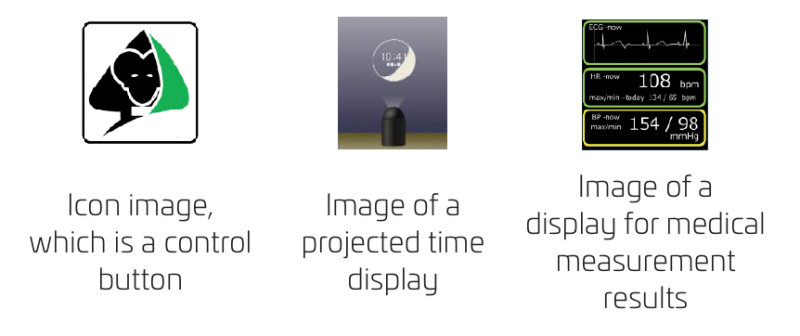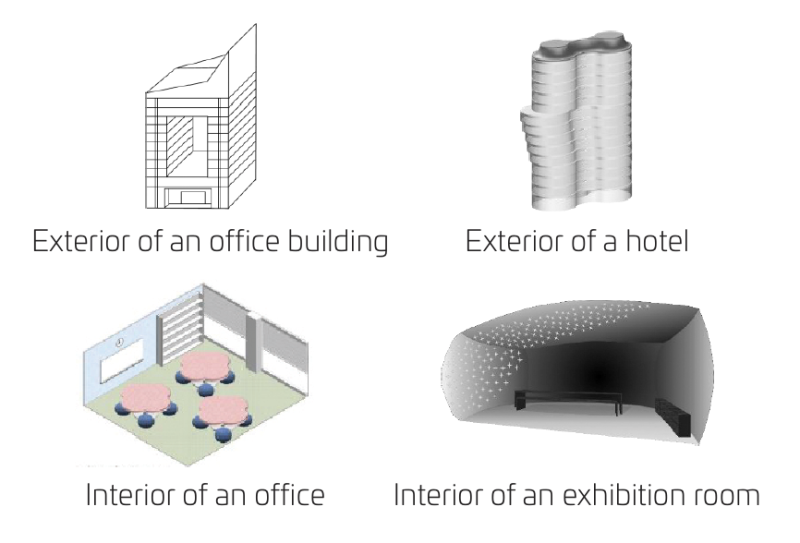Significant amendments to Japan's Design Law recently came into effect, on April 1 2020. Where the previous law only allowed design registrations for tangible objects, the amendments extend design protection to graphical user interfaces (GUIs) and the design of exterior and interior decorations on buildings.
While the new amendments allow for much broader protection for companies in a vast range of industries, they could also create a potential minefield of design rights.
Expansion of the scope of protection
Protection of image designs
The amendments allow design protection of images that temporarily appear on displays as well as designs of images that are projected onto physical items (such as roads, walls, or even the human body). For example, designs such as GUIs and applications for online shopping sites or navigation systems on the internet are protected. Some examples that the Japan Patent Office (JPO) has provided include these:

"2020 Revised Design Law, Outline of the revised design examination criteria" (Japan Patent Office)
For the JPO to recognise protection for such designs, the following criteria will need to be met:
i) the design must create a "uniform aesthetic appearance as a whole"; and
ii) the design images will be used for operation of a device or the design should appear as a result of the device's functionality.
The law before the amendments did allow for some protection of GUI image designs, but only insofar as they are recorded in a device and appear on the device, as with traditional forms of application – that is, non-cloud based applications. Now, GUI image designs which are not recorded within devices themselves, such as cloud-based applications, and even GUI image designs which are projected onto physical items, may also have protection.
One Japanese company looking to actively embrace this aspect of Japan's design law is the Tokyo-based consumer-focused navigation app developer Navitime Japan. General manager of the legal department at Navitime Japan, Akira Mashiko, explains that to his company, this aspect of the design law reforms is most beneficial: "While image designs that were included within software or apps that were installed on hardware could have been protected before the amendments, the scope did not extend to designs that displayed on a device via the cloud. This left companies that already were actively involved in protecting designs with inadequate protection. With the amendments, the superficial distinction now falls away.
"Also, the amendments now align the design laws with how the actual apps are being used by businesses. Therefore, this would be good for the companies which were in this inadequate position and were trying to properly protect their intellectual property," says Mashiko.
On the other hand, Mashiko mentions that it seems that cloud-based companies have, to date, had very little engagement in IP law protection and also that the design law amendments are still not widely recognised in the industry. Mashiko says it will be interesting to see how the industry embraces the amendments.
Mashiko adds that Navitime Japan will look to actively protect "potentially valuable designs," adding: "Seeking design protection may be one of the options we take when our products or services cannot be adequately protected by patents."
Mashiko points out that "for companies that have not previously engaged in design protection or design research, searches may be burdensome. It is expected that the JPO's search tools will be enhanced for the purpose of searching."
Mashiko adds that until judicial precedents develop over time, the scope of protection may also remain uncertain.
Discussing market dynamics, Mashiko explains that "in the smartphone navigation app business, we take into account how regular users interface with our app, and come up with new designs. To give the users understandable directions, we need to do this through good interface design, and such interface design can give a company, such as ours, an important competitive advantage. Protecting such designs in competitive industries can actually enhance the industries as a whole. Extending the protection of image designs makes particular sense to me, with the development of IT and cloud-based services".
Another benefit which Mashiko says the amendments will introduce is the alignment between the Japanese system and that of the design laws in other jurisdictions. He adds: "Alignment in the various countries will allow companies to have more opportunities in doing business outside of their home country."
Satoshi Yamazaki, general manager of the Japanese computer game app manufacturer Colopl, says: "Japan has essentially aligned its design protection with Europe and the US, by allowing protection for graphical interface designs, and design protection for the interiors and exteriors of buildings. This will no doubt be welcome not only for certain Japanese companies, but also European and US companies looking to extend their overseas design protection to Japan."
While Yamazaki says that design protection for GUIs may help certain industries in Japan, it will not necessarily help his industry: "The design law reforms for generic user interfaces need to tie the interface with some form of 'operation' or 'functionality', either within the device or outside of it. This means that social game companies are unlikely to be able to protect their game designs under these new reforms."
He adds: "Perhaps something that could reflect a function of the user's smartphone device such as the remaining battery power or the 'settings' screen could be protectable."
However, such designs are unlikely to enhance the competitiveness that a social game company has, so it is unlikely that they will feel there are merits in the design law reforms.
Protection of buildings and interior designs
Another significant amendment is that the exterior and interior designs of buildings were not protected under the previous law but are now. The JPO gives the following examples of the types of designs which will be protectable:

“2020 Revised Design Law, Outline of the revised design examination criteria” (Japan Patent Office)
Interior designs that create a "uniform aesthetic appearance as a whole" are now protectable in a single design. That means protection can be sought for designs that contain multiple object elements such as furniture (including tables and counters), decorations for walls and floor designs, as long as the design creates a "uniform aesthetic appearance as a whole". Parts of buildings can also be protected by using the partial design protection system.
However, there is reservation about these law reforms within the architectural and construction industry.
David Stewart, professor of architecture at Tokyo Tech (Tokyo Kogyo Daigaku), one of Japan's leading universities for architecture, describes this aspect of the amendments as being a "potential minefield" should architectural firms and partnerships readily start protecting their every interior and exterior design.
"The degree of 'originality' is very hard to determine, apart from technical and material innovations. These are subject to patent law in most jurisdictions and belong to a different, if related, discussion, even if the ultimate resolution of an architectural design may be totally dependent on one or more such technical advances in any given situation."
Stewart acknowledges that a registration system for IP such as trademarks makes sense for the purposes of guaranteeing the origin of a product and ensuring quality. He also sees a place for protection of product designs and graphics owing to their direct involvement in company marketing initiatives.
"But with architecture in the larger sense, it runs against the whole way in which the fine arts have always matured, modified and developed. Only everyday commercial architects need this kind of security blanket – and only when designs are actually reproduced more or less verbatim in a point-of-purchase context."
He adds: "Architects in general are of course aware of the present-day emphasis on IP. As fees in this profession are low in comparison with, say, medicine and law, licensed architects are on the lookout for compensation, but it is doubtful that design registration as such would afford this.
"Architecture and the visual arts have only ever built upon imitation and experiment in an open field, one where 'imitation is the sincerest form of flattery'. In addition, a professional designer should probably be willing to undertake any building type, if workload and staffing conditions permit, which may not be the case in a smaller office. There was a time when such matters were openly discussed in print as aspects of practice."
He continues: "More recently, the profession has slipped into a sales-oriented mode derived from fashion and product design, constituting a limited critical discourse oriented toward prize-giving and the achievement of celebrity status."
According to Stewart, attempts at design legislation have existed in other countries, "but the reality is that they have not succeeded". Proving something is original in the first place is usually too hard, he argues.
"If intellectual property law in this area needs improving, it would be better to enhance an architect's moral rights. Yet moral rights can too easily be waived or worked around, allowing distinguished architectural pieces to be ruined through careless remodelling or razing and replacement. Moreover, the system of 'listed buildings' that implements moral rights of usually deceased (but increasingly also of living) architects may well lead to stagnation, as has occurred in California, Australia and many countries in Europe, notably Italy and France. So not only is this a minefield but also a conundrum."
Such concerns are echoed by Paris-based interior designer Harumi Simon, who has Japanese heritage and Japan-based clients: "While the design protection of novel or landmark architecture may be required, on the other end of the architectural design spectrum such as with a small business like myself, I would not see the design protection of residential interior projects as essential."
Referring to unregistered design rights, Simon says: "In France our plans, 3D designs and built works are automatically protected by law, which would satisfy my rights as a designer for the scale of projects that I create. To pay for additional protection would be an unnecessary expense of both time and budget. There is a grey zone when it comes to inspiration and plagiarism in the world of architecture. It remains impossible to tell if a design has never been conceptualised before, but I believe that reputable designers will use their moral code to use current architectural trends and inspirations and transform them into their unique designs."
A Tokyo-based design director for a global architecture firm considers that certain types of architecture may have value with design registration protection. "There would be benefit in protecting design elements which are repeatedly used by architects, and where anyone in the world would recognise such design elements as identifying that architect."
The design director also recognises the double-edged sword that the design law amendments introduce: "On the one hand, design registration could give design offices a competitive advantage for designs that they repeatedly and exclusively use. If design guidelines are developed with respect to shop designs and office interior designs that are used repeatedly by a client, then I can see the benefit of protection of such designs. This could give design offices a good repeat client. On the other hand, if other competing agencies register designs in a similar manner, that could result in the design offices being unable to offer that client a design that uses the competitor's design registration. In addition, the fact that novelty can be easily lost through disclosure in the media also creates some timing concerns," she says.
Related designs and duration
Other key reforms under the amendments include the broadening of what is considered a "related design" and an increase in duration of design registration protection. "Related designs" to the originally filed "base designs" were protected under the previous law but in a restricted manner. The scope of such designs has been broadened under the new Design Law, as summarised in this table:
Issue |
Previous Design Law |
New Design Law |
Type of design to be protected as a “related design”. |
Only designs similar to the “base design”. |
Designs similar to the “base design” and those similar to a “related design”. |
Timing to file “related design” applications. |
Before issuance of an official gazette, which announces the registration of the “base design”. (Currently the term is around eight months from the application date of the base design.) |
10 years from the application date of the base design. |
The idea is for a broader range or series of designs to be protected, without as much time pressure on the base design owner. Any industry where design variations or a series of designs are created could enjoy the benefit of this new amendment.
The duration of design rights has increased from 20 years from the registration date to 25 years from the application date. The design rights protection period became the same as Europe (25 years from the application date). This is in comparison to 15 years from the registration date in the US, 10 years from the application date in China, and 20 years from the application date in Korea.
Expansion of indirect infringement
The Design Law prohibits "indirect infringement", in which preliminary and accessory acts that are highly likely to induce infringement will also be regarded as infringement.
Under the revised Design Law, this has been expanded to include acts of dividing infringing products into components and manufacturing or importing such components for the purpose of avoiding crackdowns. These acts may be deemed as "infringement" under certain conditions, such as "knowing that the components will be used for the compilation of the entire design".
This should plug the loophole which sophisticated counterfeiters took advantage of, which was to break up and import as separate components a product covered by a design right, in order to avoid infringement.
Likely uptake
From our interviews with industry experts, what has become apparent is that the mood with regard to the design law reforms varies considerably from industry to industry. At one end of the spectrum, companies such as Navitime Japan appear to welcome the reforms that will allow protection for GUIs. In the middle of the spectrum would be companies such as Colopl which find that the reforms probably add little benefit to their industry. Then there is the architectural and construction industry, where some have concerns that the reforms may cause uncertainty or unnecessary burdens.
It will be interesting to see the uptake of new designs that the reforms allow for, and the industries that will focus upon them. Certainly, the scope of protection has broadened and may allow some designers to recoup their investments.
No doubt we will also see new designs protected for new forms of technology and culture. Hopefully the benefits that the design law reforms provide will, overall, outweigh the demerits, particularly if designs can be easily searched and registered. In turn companies should now have a new avenue to enhance the protection of their new valuable designs.











